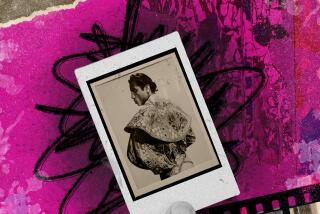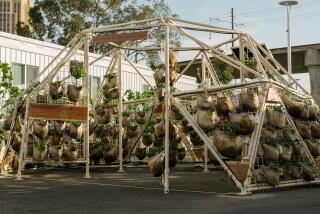Getty Research Institute launches African American Art History initiative, acquires Betye Saar’s archive
The Getty Research Institute announced Tuesday the creation of an African American Art History Initiative with the acquisition of the archives of Los Angeles assemblage artist Betye Saar.
The initiative, which launched with a $5-million endowment, aims to establish the Getty as a primary center of scholarship, research and education for African American art and as a model for like-minded endeavors in the field.
“It’s taken a long, long time for the art world in general to figure out that there are African American artists,” said Saar, 92, over the phone from her studio. “Fifty years ago, we didn’t have the kind of recognition we have today, and it still has a long way to go.”
The Getty initiative, however, signals some real advancement, Saar said.
The program’s mandate includes acquiring archives; the appointment of a curator and bibliographer in African American Art History; annual research fellowships; a plan to conduct oral histories of notable African American artists, scholars, critics, collectors and art dealers; and institutional partnerships with the goal of digitizing existing archival collections and collaborating on joint conferences, publications and research projects.
“It’s not about building these things at the Getty for the sake of the Getty; it’s about building these things for the sake of the community,” said James Cuno, president and chief executive of the J. Paul Getty Trust. “We’ve got the experience and resources for building up a rich archive to advance our greater understanding of African American art in our history.”
It’s taken a long, long time for the art world in general to figure out that there are African American artists.
— Betye Saar
Kicking off the initiative with the acquisition of Saar’s archive is a promising start to accomplishing those goals, said Sophia Belsheim, deputy director of the Leimert Park-based gallery and social services organization Art + Practice, which was co-founded by artist Mark Bradford.
A+P is one of the groups that the Getty initiative plans to collaborate with. Belsheim doesn’t know what form that collaboration might take yet but says that public exhibitions will likely be a key part of it and that she’d love to start with Saar’s work.
“It’s always so exciting to see artists who have had these very long careers be recognized while they’re still alive,” Belsheim says of Saar. “She is phenomenal. I’m a huge fan.”
REVIEW: Betye Saar’s gun-totin’ mammies turn stereotype into power at the Craft & Folk Art Museum »
Saar said that she was in talks with the Getty about her archives for quite some time before they brought up the idea of an African American art history initiative. She toured their archive and research facilities and was hugely impressed with the level of care and efficiency she saw. For her, it was a relief to know that her extensive personal collection of journals, art and general life ephemera would be kept in a place where her grandchildren could one day come to see it.
Saar’s archive spans her entire life, beginning in 1926 through the present day, and catalogs the groundbreaking work she did in the 1960s and ‘70s when she was a part of a vibrant arts scene in Los Angeles. She used found objects in conjunction with her own drawings, prints and etchings to create powerful assemblages, often with potent political messages.
One such piece is “The Liberation of Aunt Jemima” (1972), which re-imagined the derogatory female back figurine from the popular pancake brand as a symbol of black power, complete with a rifle and raised fist.
“When you’re 92, it takes a lot to get you excited. I paid my dues, and now, I’m reaping the rewards,” Saar said with a laugh. “I’m very happy that anybody can go [to the GRI] to discover my work, not just the art community. It’s my contribution.”
To help shepherd that contribution and those to follow, the GRI has recruited MacArthur Fellow and African American art scholar Kellie Jones as a senior consultant. Jones’ books include “South of Pico: African American Artists in Los Angeles in the 1960s and 1970s” and “Now Dig This: Art and Black Los Angeles 1960-1980,” published as a companion to an exhibition by the same name in the 2011 Getty-funded “Pacific Standard Time: Los Angeles Art 1945-1980.”
Additional institutional collaborations include the UC Berkeley Oral History Center, the California African American Museum and the Studio Museum in Harlem, as well as a variety of historically black colleges and universities such as Spelman College in Atlanta.
“The really important thing is we can do this, but we can’t do it alone — we need partners and need resources to fund this,” said Cuno, adding that as word spreads about the initiative and the many programs get rolling, the GRI will continue to forge valuable relationships across the country. “At the Getty we are devoted to — and rooted in — building up research and promoting scholarship.”
More to Read
The biggest entertainment stories
Get our big stories about Hollywood, film, television, music, arts, culture and more right in your inbox as soon as they publish.
You may occasionally receive promotional content from the Los Angeles Times.







